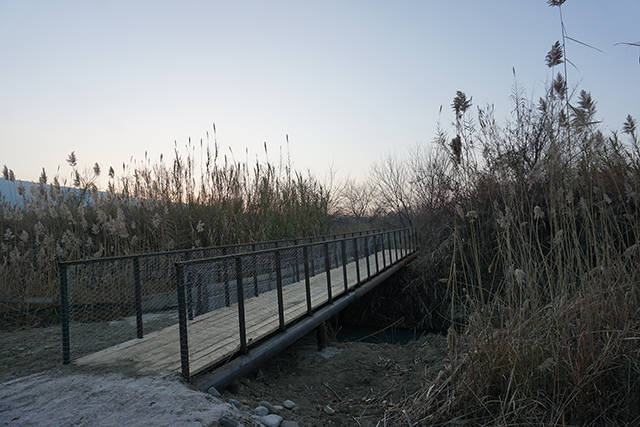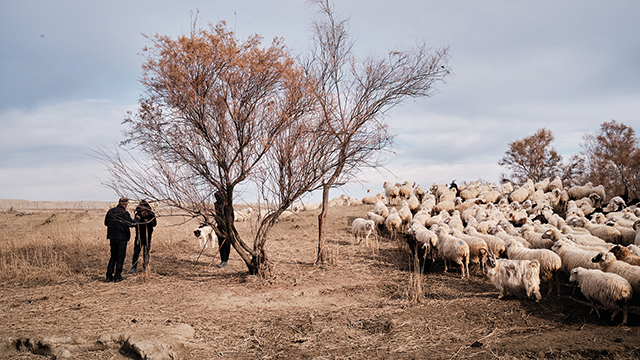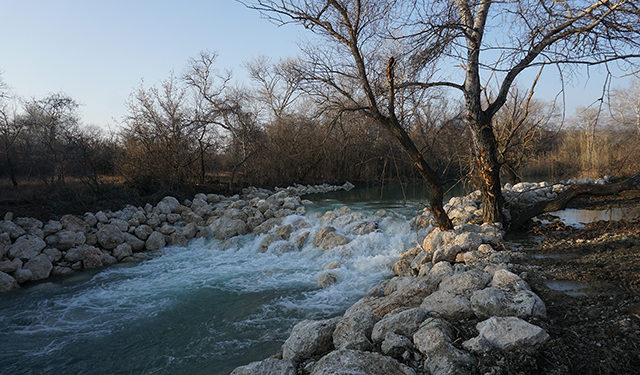When it comes to achieving significant results, paperwork alone is never enough. Reaching high goals needs continuous practical work and direct contact with stakeholders. One of the most distinguished organizations in this regard, well-known for its dedicated practical work and activities in Georgia, is SABUKO, (Society for Nature Conservation and Birdlife Partner in Georgia) which aims to protect and restore ecosystems and at the same time ensure the sustainable use of natural resources without significantly affecting economic activities.
One recent and successful project being implemented by SABUKO is ‘Restoring Gallery Forest and Grasslands in the Iori River Valley.’
The Iori River, located in Georgia’s Dedoplistskaro municipality, and the gallery forest stretching along the valley, are integral parts of south-east Georgia’s steppe ecosystem. Yet, the steppe areas have been subjected to over-stocking with livestock, causing overgrazing, erosion, and competition with native herbivores. There is also the biodiversity of Chachuna Managed Reserve located nearby, which has faced a severe problem of degradation due to unregulated grazing.

Introducing a solution – rotational grazing scheme
To improve the dire situation on the ground, SABUKO has been implementing the landscape restoration project since January 1, 2019, with the support of the Cambridge Conservation Initiative. As part of the project, the organization developed a rotational grazing scheme.
In order for the grass to grow, the area needs to be rested for some time from grazing. SABUKO presented a rotational grazing scheme to the Agency of Protected Areas, which put this point in its contract with farmers. Initially, some farmers were skeptical about rotational grazing, but when it was planned and implemented with one, others also became interested and followed their example.
Rotational grazing turned out to be fruitful, as, afterwards, better grass grows in the area. This made the whole team of SABUKO very happy and proud. The results are truly promising, bringing hope that despite degradation, the unique biodiversity existing on the ground can be maintained and restored.
SABUKO and its partner organizations spare no effort to use the opportunity for restoration, and as a result of this active work, very tangible results have been achieved, though there are still a lot of things to be done.
To raise awareness of degradation and sustainable land management, SABUKO made a short documentary film which was recently premiered for a wider audience and received very positive feedback.
On December 14, SABUKO and EcoFilms presented to the public the first documentary about the Chachuna Reserve, entitled ‘Facing the Desert.’
The documentary covers the ecological problems existing on the ground and possible ways to establish sustainable use of natural resources.
The audience attending the presentation of the film also had the opportunity to see the works of photographer Natela Grigalashvili from the Chachuna Reserve. Under the Artists’ Residence Program, supported by the Cambridge Conservation Initiative, the photographer will work for a year in the reserve to document the interaction between Man and nature. These photos were taken at the very beginning of this project.
At the event, it was also possible to see footage of rare wildlife species living in the territory of the Chachuna Managed Reserve, taken by photo traps installed by SABUKO.

Successful Cooperation with State Structures
The recent period has been marked with an important change at the legislative level: for two years, the team of SABUKO has been actively trying to introduce a definition for the permissible amount of cattle grazing per hectare, in cooperation with state structures, by sharing research. Legislative innovation has already been adopted in the current quarter to define that permissible amount, which is very important for biodiversity conservation. The above legislative change currently applies to state-owned pastures.
The practice of mutual cooperation between the non-governmental agency and the state structure implemented by the adopted regulation can be considered very successful.
“The problem was that the legislation regarding pastures was very general- there were no relevant normative acts,” Tinatin Arveladze, Policy Manager, explained. “The above change was one of the first steps towards the sustainable development of pastures the state could make.”
“The legislative change was adopted on 6 October 2021. SABUKO contributed to this process even prior to introduction of the legislative regulation, as it developed a rotational grazing scheme. For example, when two pastures were leased in the territory surrounding the Chachuna Reserve, the pasture tenants were instructed to follow SABUKO’s rotational grazing scheme as enshrined in the lease agreement by the Agency of Protected Areas. This was gradually implemented in practice by those who grazed sheep in this area. Adopting the legislative act was a big goal for SABUKO, and a result of a lot of enthusiasm, which was also met by the local municipality and the Agency for Protected Areas.
However, a legislative act alone is not enough, as protecting and restoring biodiversity is also a matter of each shepherds’ personal responsibility.
“Monitoring is also an important issue,” Arveladze noted. “A new Land Agency is to become the main agency in terms of sustainable management of these pastures. However, it doesn’t have enough resources for constant monitoring. If no monitoring is carried out on how this obligation is being fulfilled, this record will remain a mere formality. Having enough human resources, experts who would evaluate the condition of grass cover, is crucial in this process. In SABUKO, we have a qualified German expert, but in general, a shortage of experts in the field is notable in Georgia.”
Nata Sultanishvili, Head of Planning and Development Service at the Agency of Protected Areas, assesses collaboration with SABUKO as “very active and successful.”
“Previously, there was no management plan or relevant studies conducted in terms of the sustainable management of pastures in the Chachuna Managed Reserve in the Kakheti region. Thanks to SABUKO, in a close collaboration with the Agency of Protected Areas, this was achieved and a plan was developed that defined the permissible amount of cattle per hectare in the area.
“There is a very good international and local practice that protected areas are managed with a Management Plan, where programs of various directions are determined and the relevant actions and steps are taken. The Chachuna Reserve didn’t have such a plan before. Together with SABUKO, we created one.
“However, adopting an act is one issue, and monitoring its implementation is another,” she added.
“Accordingly, the management of the Agency of Protected Areas and our rangers will be actively involved in this process to verify compliance with the terms of the contracts.
“Various measures have also been taken to prevent cases of overgrazing, such as fencing off certain areas, which is also very important. In addition, the organization works very actively to protect the biodiversity existing on the ground. Such actions eventually serve the goal of strengthening the eco-tourism in the country, which is crucial for the economy,” Sultanishvili notes.
The administration of the Chachuna Managed Reserve is also very thankful to SABUKO for their hard work.
“We’ve been successfully collaborating with SABUKO since 2019,” Sultanishvili says. “Their team has drawn up better development ways for the unique flora and fauna existing in the area. They’ve done a great job. Together, we installed photo traps in the Chachuna Reserve and surrounding areas to detect unique wildlife species. As such, our photo traps detected an endangered Eurasian lynx which we knew that lived in the Chachuna Reserve, but couldn’t have been detected before.
“Yet another important issue was water supply to floodplain plants. Due to the characteristics of the River Iori, which is the main source of water on the ground, it was very difficult before. SABUKO implemented a great project, as part of which soon the level of the water will be artificially raised using stones, and floodplain plants will be watered. As the floodplain of Chachuna Reserve is degraded, we, the reserve administration, and SABUKO, are doing whatever we can to improve the situation and revitalize the ecosystem.
“Development of ecotourism services is also carried out on the spot through the efforts of SABUKO. For the lovers of birdwatching, a wonderful observation spot has been arranged. Tourists can watch unique species of birds living here, such as the Eastern Imperial Eagle. Soon, the infrastructure will be further improved and more hiking trails will be added to the area,” noted Natia Zurashvili, Representative of the administration of Chachuna Reserve.
“We’ve been collaborating with SABUKO as part of the project ‘Establishment of Dedoplistskaro Biosphere Reserve in Kakheti as a Model of Sustainable and Inclusive Development,’ funded by the EU and implemented by REKI and the Dedoplistskaro Municipality,” says Lali Tevzadze, Biodiversity and Sustainable Development Programs Manager from the organization Reki. “One of the components of the project was restoration of floodplains in the Chachuna Reserve. SABUKO has long-term experience working in Chachuna. Restoration of the floodplains is not easy, and therefore, an experienced organization was necessary for such a responsible task. To protect biodiversity from overgrazing, a special corridor for the sheep to drink water has been arranged by the organization, which reduced damage to grass and allowed it to grow again. We don’t have such a unique biodiversity in many areas in Georgia, so we must all protect it with joint forces.”

Building confidence-based relations with locals
The right approach and harmonious relations with locals were yet other priorities for SABUKO, the result of which is clearly visible today.
Notably, farmers shepherding sheep in the nearby areas of the Iori River Valley, in Dedoplistskaro municipality, now have an exemplary relationship with the SABUKO team.
Aleksandre Mikeladze, Project Manager, says despite certain controversies and uncertainty among the locals towards SABUKO’s activities, which was natural before the awareness- raising campaign, nowadays they collaborate with each other very actively.
“SABUKO initially developed a different and innovative approach towards the local farmers. Unlike many other projects, where farmers are perceived as beneficiaries, here they were perceived as partners with whom collaboration was necessary for achieving a mutually beneficial goal. The organization created a special questionnaire for them, and in doing so, revealed the persons who would agree to participate in this experiment, changing their behavior and role to eliminate chaotic grazing and unsustainable use of natural resources.
“Gradually, more and more farmers got interested in taking part in the rotational grazing scheme developed by SABUKO, which, naturally, positively affects the ecological situation on the ground.
“In order to reduce grazing cases in the floodplain forest, SABUKO assessed the potential location of the areas where sheep drink water. Based on the results, SABUKO arranged eight facilities for sheep to drink water, wells, and a 2.5-kilometer corridor, which provided significant help to reduce the impact of sheep grazing on floodplain forests and the River Iori.
“Importantly, SABUKO is also contributing to building harmonious neighborly relations among the Georgian and Azerbaijani farmers living together on the ground, and it helps the Azerbaijani population overcome still existing language barriers.
“As such, this month, the SABUKO team are completing the construction of a bridge for a local Azerbaijani farmer, which will allow him to connect his land plots and introduce rotational grazing,” Mikeladze explains.
All the above useful activities have deservedly gained the organization the trust and high reputation among local farmers.

Raising awareness among youth
As ecological restoration needs a scientific base, SABUKO actively cooperates with Ilia State University, aiming to involve the young generation in this important work. As part of this collaboration, students are allowed to visit the Chachuna Managed Reserve, even live there for a certain period of time, conduct research and gain experience. Moreover, the SABUKO team collaborates with German expert in the field Marinus Gebhardt, a Natural Resources Manager who has been actively communicating with local farmers and shepherds and contributing to the development of new skills. In addition, the expert, living near the Chachuna Reserve along with his family, has been sharing his experience with the young generation.
The SABUKO team will continue to spare no efforts to revitalize the ecosystem and ensure sustainable use of natural resources in the Iori River Valley.














